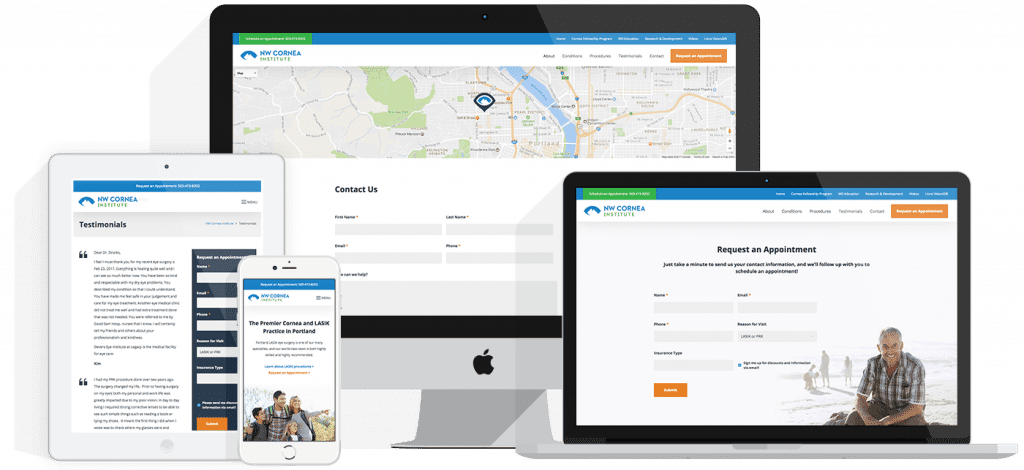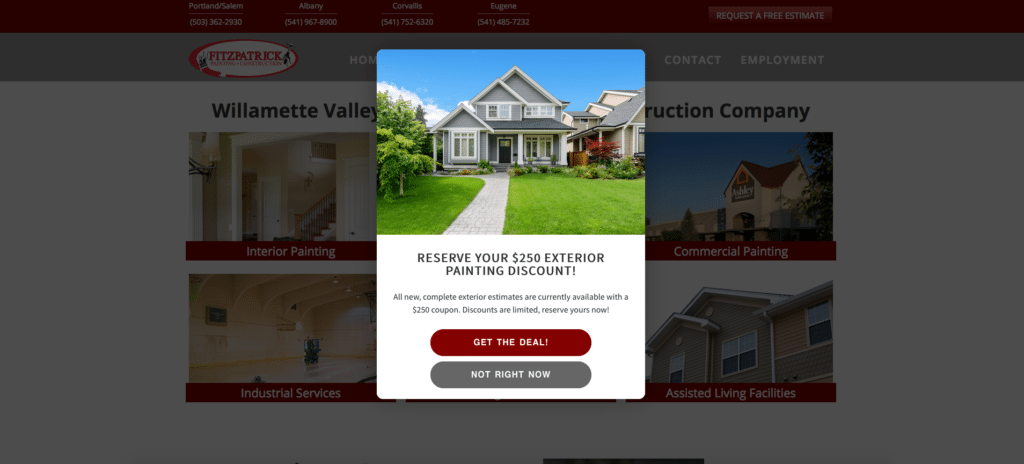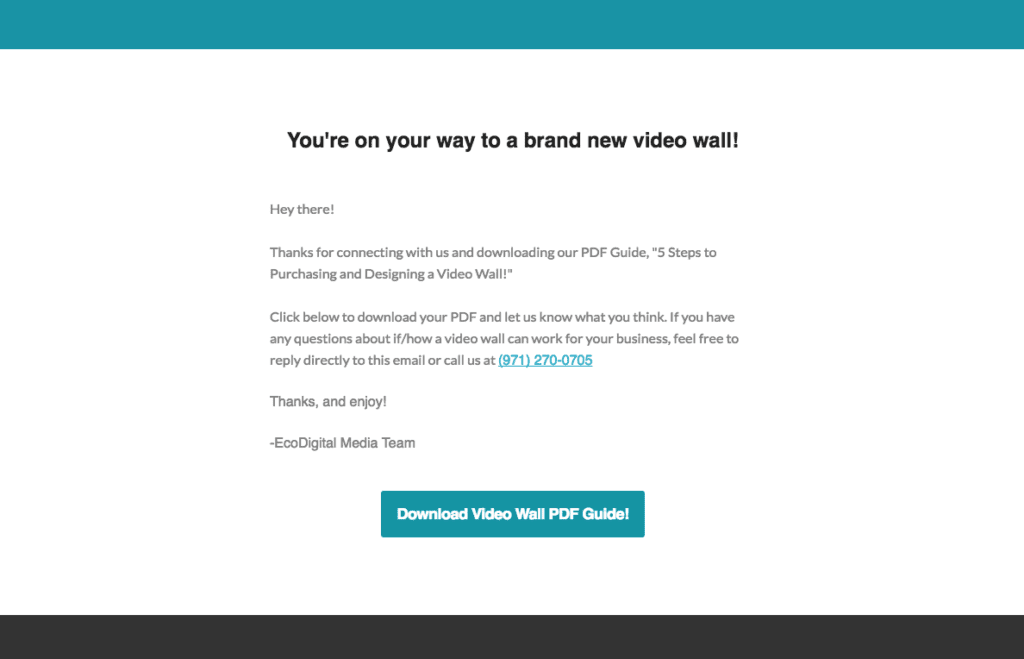
Introduction
There’s an old adage that goes, “There’s only two jobs in the world. Sales and sales support.”
Marketing is the engine that drives the world forward, whether we like it or not. And at its roots, marketing is simply communication.
Why then, can be so difficult to grow a business? Why can it be so challenging to communicate effectively with your prospects and even existing customers?
It’s because marketing is one of those things that’s simple, but not easy.
A good marketing agency can come alongside a business, not to offer a magic bullet for success, but to ask the hard questions and provide the detailed roadmap for finding more customers and connecting with them in a more meaningful way.
Chapter 1: Know Your Business, Know Your Customer
One of the first things a good marketing agency will do to help a business grow is learn about the business (gasp!). Marketing agencies have built a reputation in the past for acting like an egotistical knight in shining armor, thinking they will come in and save the day just because they have a ping-pong table in their office lounge. Not surprisingly though, that’s not how success usually happens.
Understanding Your Customer
The first component of a successful marketing effort is understanding your ideal customer. While this may seem pretty straightforward, it can actually be quite difficult. You may have some idea of demographics, but your marketing agency should encourage you to dig deeper and ask questions like:
Why did they choose you over your competitors?
What emotional connection do they share with your brand?
What are they interested in outside of work?
Putting together a customer psychographic is generally much harder than putting together a demographic, but if you stay committed to this idea day-in and day-out, you’ll start to develop a sound understanding of your ideal customer over time. There are also consultants, worksheets, and other resources that can help guide you to success.
Top Takeaway: Want to learn more about your customer persona? Talk to your best customers! It’s sounds pretty obvious, but few actually take the time and effort to talk to their best customers to learn why they enjoy doing business with you, and why they hired you in the first place.

Knowing what your customer enjoys outside of working hours can actually go a long way in helping you understand how they make decisions from 9-5.
Dial in Your Business Metrics
Another key element of successful marketing is, well, knowing what success looks like in the first place. We’re always surprised at the limited granularity that many business owners and marketing managers have surrounding their business and its overall operation. While business intuition and instinct are usually very high, we find room for improvement when working to understand the “itemized” opportunities within the business.
If you’re considering hiring a marketing agency to help your business grow, make sure they ask you some of the following questions:
What is the LTV (lifetime value) of a customer?
Which products/services can you scale most effectively as more orders/leads come in?
Which products/services are your most profitable?
What is your acquisition budget for a new sale? If you spent 10% of gross revenue on advertising to acquire the sale/customer, is that worth it?
What is your conversion rate for new leads that contact your business?
Our goal is to get as specific as we can on every component of a business’ operation. We may not be able to figure everything out, but the more numbers we have, the easier it will be to construct successful campaign and understand where the lowest-hanging fruit is.
Top Takeaway: At the very least, a good marketing agency should understand the value of a customer to your business, and how much you can spend to acquire that customer for sustainable growth.

The better you understand your business’ key metrics, the easier it will be to run successful marketing campaigns.
Chapter 2: Is Your Website Working?
For 95% of businesses, a winning website is the foundation of any successful marketing campaign. Here at Midas, our most successful marketing campaigns usually follow behind websites we design. This works because we understand the importance of a website, and how it needs to be structured, designed and executed in order to avoid any friction for potential customers.
The Importance of Your Website
Sometimes businesses compartmentalize various online marketing elements, thinking that social media or search engine marketing will grow their business in isolation. However, this is like a retail business thinking that as long as it distributes catchy promotional flyers, their storefront can be messy, outdated and unorganized. Silly right? The online world works the same way. Social media, search and other marketing channels may offer your business opportunities to connect with customers and bring them to your website, but if your site isn’t built to communicate clearly, add value, and convert, your honestly wasting your time and money.
Top Takeaway: Marketing to a bad website is just as detrimental as a retail business mailing out beautiful flyers only to have a messy, unorganized storefront. Take your website seriously!

Many hear that a specific marketing strategy, such as Facebook Ads, is crucial for business success. While this may be part of the equation, a poor website will immediately turn away all your Facebook visitors – even if they are responding very well (high click-through rate) to your ad on the Facebook platform.
Benchmarking Your Website
Wondering if your website is “good enough” to put the foot on the gas with a marketing campaign? Here are a few questions you can ask:
-Has it been more than 4 years since you’ve redesigned your site?
-Is your website fully mobile-responsive, looking just as good on a phone as it does on a computer?
-Does your site clearly guide potential customers to your primary website goal, like requesting a quote?
-Is your site updated actively with new products, staff members, blog posts, and other content?
-Do you know how well your website is performing currently?
It may be tempting to want to just rush into a marketing campaign, but considering your website first and foremost is almost always a must for a successful campaign.
Top Takeaway: Download our checklist and work through it with your team to determine how you’re doing. After you’re done, contact us and we’ll be happy to take a look ourselves and offer any tips and pointers we might see!
Chapter 3: Building a Funnel
Once your website is built (or rebuilt), and you have a deep, well-defined knowledge of your customer, your ready to start filling your pipeline with leads. There’s a few different ways to do this, but almost all strategies incorporate three elements: an invitation, an offer, and the initial email sequence.
The Invitation
The invitation is how you present your offer, which will get into next. While the offer is important, its presentation goes a long way in determining how well it attracts customers. Having an opt-in box or chat window pop up on your website is an example of an invitation. However, if this is set to immediately pop up as soon as a visitor gets to your site, you’d better have a killer offer for your prospect or else they will likely be annoyed by this intrusion and bounce from your site.
A better strategy may be to offer to email a discount coupon for a specific service based on certain pages on your website. For example, a painting company may offer an exterior painting discount for new customers, and set the promotion to only pop up when a visitor is on their exterior painting services page.
In summary, the invitation is your presentation of your initial offer, whether its a PDF download, discount, case study, or a direct link to a certain landing page on your website. Be strategic about how you present your offer, giving special consideration to your ideal customer persona.
Top Takeaway: Getting in the mind of your customer is crucial to proper presentation of your offer. Do it right, and you’ll build trust and rapport before they even contact you. Be too aggressive or unfocused and you may actually leave a bad brand impression.
The Offer
Everyone loves a discount, a freebie, or other valuable resource. This is especially true for new prospects who may need a little more nudging than your existing customers. Offers are usually presented via an invitation either through a landing page, opt-in window or something similar.
The idea here is to offer something of value in exchange for an email address and permission to market to that email. Seth Godin dubbed this permission-based marketing. Here are a few examples of what business offer their customers:
-An online retailer may offer 15% off a new customer’s first order
-A painting company may offer $250 off an exterior repaint
-A SaaS company may offer a 30-day free trial of their software
-A technology company may offer an in-depth case study of its product
Be strategic about both your offer and invitation, and let your prospects know that they’ll get instant access to the offer by signing up for your email list. Once they sign up, they’ll receive their offer and your funnel is now starting to grow!
Top Takeaway: Look to other competitors in your industry if you aren’t sure what to offer your customer. Try to solve a pain point or give them something of value that doesn’t take too much away from your bottom line.

Whether you want to capture email leads as discussed in this article, or drive traffic to a specific webpage as shown here, you have to be intentional about the goals of your website in order to effectively generate leads and close more deals.
The Email Sequence
Once a potential customer opts in to your list and claims your offer, you have to deliver! The problem here, is it takes a lot of effort and attention to constantly be monitoring your website and prospect activity. What’s the answer? Email automation!
Email automation is basically setting up a sequence of emails to go out to your new prospects after their get on your email list. An example of an email sequence would be sending new contacts three emails over the course of the first week after their claim your offer. Email sequences can be as simple or complex as you make them, but one example might look like this:
Invitation: A pop-up box offers a free trial for a software company once a visitor navigates to the pricing page.
Offer: Potential customers are able to use the software for 30 days for free.
Email sequence: The first email is sent immediately after a subscriber claims the offer, giving the prospect a code to use the software for free for thirty day. A handful of other emails may go out over the duration of the trial, offering customer testimonials, case studies, and opportunities to schedule a demo to learn more about using the software. As the trial period comes to an end, a few emails may be scheduled to offer a discount for the first few months of becoming a paid customer of the software.
Top Takeaway: Email sequences, and building funnels in general, is no easy task. While it is possible to manage it on your own, usually hiring a marketing agency to help guide this process will position your company for success in the long run.

Your lead magnet delivery email should always include a soft call-to-action for the prospect to take the next step closer to becoming a customer, such as booking a consultation or scheduling a demo.
Chapter 4: Marketing Campaign Components
Once your website is ready to go and your funnel is in place, you’re ready to put together a marketing campaign to effectively grow your business. Different strategies work for different businesses, but all good digital marketing campaigns will include some, if not all, of the components below.
SEO
Search engine optimization (SEO) is the process of positioning your website to be seen by Google as an authority in your industry for your businesses key products and services. Doing this well is rewarded by Page 1 rankings for your top keywords. SEO is a combination of website optimization, content marketing, and linkbuilding. SEO campaigns often need a longer runway for success, but once your website starts ranking well, your business will benefit for months and sometimes years down the road.
To learn more about SEO, visit our SEO services page.
Paid Advertising
Paid advertising is directly paying for clicks to your website (or another form of immediate engagement). Google Adwords and Facebook Ads are two common forms of paid advertising in the digital marketing realm. Unlike SEO, it’s possible to see immediate success with your paid advertising campaigns. However, once you stop paying, your traffic will stop coming in as well.
Content Marketing
Content marketing is often considered part of SEO (and rightly so), but it deserves its own distinction. Content marketing, simply put, is building trust, thought leadership, and visibility in your industry by producing and sharing valuable content. While an active and strategic blogging effort drives a content marketing campaign, other elements such as social sharing tactics can reinforce your content, leading to a full-on inbound marketing program. As both search and social shift more towards “meaningful marketing,” producing interesting content is now a must for just about every business’ marketing strategy.
Email Marketing
Email marketing is one of the most preferred and profitable marketing channels for many businesses. Why is this? Because people on your email list already have some sort of relationship with your brand, meaning there are less obstacles to overcome to move your prospects down your funnel. As you already “own” the audience, your only fees for email marketing are the cost of using your email platform (usually pretty nominal), and the time it takes to manage your email marketing effort. In an age of shifting social networks and anticipating the trends of search, email remains the one constant to nurture your prospects and reinforce value with existing customers.
Social Media
Social media means a lot of different things to a lot of different business. It’s an ever-changing jungle filled with plenty of opportunities for the businesses that can keep up. From a high-level, social media is often a place to start new relationships with prospects and reinforce value with your existing “tribe.” It’s usually not smart to push your products and services too hard on social media as people are on social networks to “hang out.” However, social does provide great opportunities to build brand equity and grow your tribe when it’s managed effectively.
Print Marketing
Print marketing has taken a backseat to digital over the last decade, but as the online world gets more crowded, print is finding opportunities to make a comeback. Having winning business cards, brochures, and direct mail pieces can now be way to separate yourself from your competition and leave a lasting impression in the mind of your prospects and customers.
Top Takeaway: Developing an understanding of your customer is critical to properly know which marketing channels to pursue. If your business is sells apparel to young adults, a channel like Instagram is a must. If you are a B2B company selling specific, niche products, you would want to consider a good SEO plan to make sure your products show up in online search engines.

Once you’re confident you have a website that will inspire action from your ideal customer, only then does it make sense to fuel up your business with a marketing budget.
Chapter 5: Understanding Your Marketing Performance
You might be tracking with us so far, but at the end of the day you need to know that partnering with a marketing agency to grow your business is actually going to work. And unless you are super familiar with Facebook Ads, Google Analytics and the code to your website, evaluating digital marketing performance can feel a bit like an overwhelming mystery.
While this is certainly understandable, here are four things to review and you determine how well your marketing efforts are paying off.
ROI: Analyzing you conversion rates, customer lifetime values, and other metrics to determine your actual return on your marketing investment.
Equivalent Value: Comparing your digital marketing spending to more traditional forms of advertising as well as cross-checking against your various digital channels.
Brand Equity: Monitoring your overall reach and engagement to grow your brand value for the long run.
Overall Business Growth: How your business is doing when all the dust settles.
Let’s look at each of these a little bit closer.
Return on Investment (ROI)
This is the holy grail of most digital marketing campaigns, and can be calculated once you answer the questions above in our “business metrics” section of this article. For campaigns we run, we set up goals within your website analytics to track performance as closely as possible.
Equivalent Value (EV)
ROI can be harder for some businesses to track than others, depending on how many offline components are involved in your sales process, or how valuable brand equity (tough to measure online) is for your business. Equivalent Value (EV) is a way of comparing your marketing against other marketing channels, so you at least know if you are spending your dollars wisely. Valuing organic traffic is often used as a way of calculating EV vs. something like Google Adwords. If your website is getting 1,000 clicks per month from online search engines, and the average cost-per-click with Google Adwords if you were paying for those clicks directly is $2.00 per click, you know your organic traffic has an EV of $2,000/month. Over time you can compare that with your SEO budget to make sure you are spending in the most effective way possible.
Brand Equity
One of the harder metrics to grasp, at least for most small and mid-size businesses, are intangible concepts like audience reach and brand impressions. We all know that every single time a prospect sees your ad, you’re business is better off – even if they don’t take action right away. In fact, it may take years of this before a prospect reaches out and connects with your company. So while it’s hard to measure, it’s very important. Our goal with campaigns that we run is to always be ROI positive, knowing that the reach and impressions from the campaign is icing on the cake and will pay dividends over time for our client.
Overall Business Growth
The bottom line when running a campaign is of course, overall business growth. In many cases, this is where the added benefit with things like brand impressions and top-of-mind awareness come into play. Unless there is a significant outside factor (losing a big source of revenue unrelated to marketing, etc.), evaluating your overall business growth is a good way to see how well your marketing agency is guiding your business forward.
Top Takeaway: A victorious marketing effort starts at the very beginning. If you know your customer well and understand your business inside and out, marketing starts to turn into a plan to execute rather than a mystery to be solved.

While marketing will always have its creative, “colorful” side, good marketing is based just as much, if not more, off strong analytical understanding.
Summary: Partnering with a Marketing Agency
Congrats! You made it through an extensive but hopefully informative article on how a marketing agency can help your business grow!.
The TL;DR version goes like this:
Know your customer like you know a friend, and develop a good grasp on your business’ key metrics.
Then…
Build a great website that will serve as an effective salesperson working 24/7 on your behalf.
Then…
Create an irresistible offer to generate new top-of-funnel leads for your business.
Then…
Once you have built a profitable, lucrative offer in place, turn on the marketing jets to drive traffic to your site and watch that traffic turn into new leads!
Then…
Take time to review and evaluate your marketing performance to make sure everything is working.
There’s no magic bullet to marketing, but there are proven & timeless marketing elements that are ready to be put to work for your business’ success.
Are you considering hiring a marketing agency? We know someone, who knows someone, who knows someone….OK just kidding, it’s us. Contact us to get started!
2 Comments
Pingbacks
-
[…] and building a great reputation for themselves. While this might have something to do with their marketing, that reputation would be meaningless if they’re products didn’t back it […]
-
[…] need a digital marketing agency to help manage your marketing efforts. Here are the various ways a marketing agency can help you skyrocket your […]
[…] and building a great reputation for themselves. While this might have something to do with their marketing, that reputation would be meaningless if they’re products didn’t back it […]
[…] need a digital marketing agency to help manage your marketing efforts. Here are the various ways a marketing agency can help you skyrocket your […]



